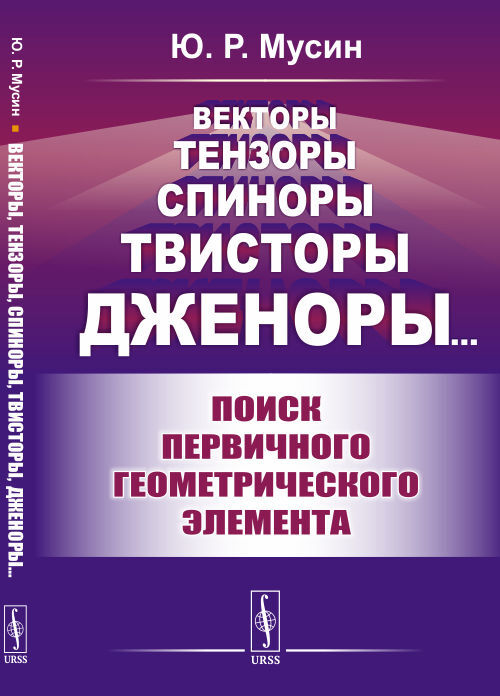Какие геометрические объекты лежат в основе Мироздания? Что нового внесли бурно прогрессирующие последние полвека математика и физика в обыденные представления о геометрии, излагаемые в школьных и институтских учебниках? Эта небольшая книга дает первые представления о математических конструкциях, как давно используемых физиками (векторы, тензоры, спиноры), так и возникших недавно в недрах современных попыток согласовать чисто геометрический подход общей теории относительности и алгебраический по существу подход квантовой механики.Краткий (по необходимости) исторический обзор развития понятия числа и непростых путей внедрения в практику векторных и тензорных методов будет интересен широкому кругу читателей. Знакомство с новыми геометрическими идеями, предлагаемыми современными конкурирующими физическими теориями (теория струн, петлевая гравитация, суперсимметрия), будет полезно не только будущим физикам, но и более широкой аудитории. Целью данной работы является донесение до этой аудитории новой парадигмы о базовых элементах, образующих геометрию нашего Мира, и о попытках выхода за ее пределы.Musin Yu. R. «VECTORS, TENSORS, SPINORS, TWISTORS, GENORS ...» (Finding a Primary Geometric Element)What geometric objects are at the heart of the Universe? What new have been introduced by mathematicians and physics, which have been rapidly progressing over the past half century, into the everyday ideas about geometry, presented in school and college textbooks? This small brochure gives the first ideas about mathematical constructions, both used for a long time by physicists (vectors, tensors, spinors) and recently arisen in the depths of modern attempts to reconcile the purely geometric approach of general relativity and algebraic is essentially a quantum mechanics approach. A brief (if necessary) historical overview of the development of the concept of number and the difficult ways of introducing vector and tensor methods into practice will be of interest to a wide range of readers. Familiarity with new geometric ideas offered by modern competing physical theories (string theory, loop gravity, supersymmetry) will be useful not only to future physicists, but also to a wider audience. The purpose of this work is to convey to this audience a new paradigm about the basic elements that form the geometry of our World and about attempts to go beyond it.
Сумма:
Оформить
Вход
- Вход
- Регистрация
- Восстановить
Личные данные
Здесь Вы можете указать/изменить личные данные для максимально комфортного взаимодействия с магазином.
MyBooks книжный интернет-магазин
ДАТА ЗАКАЗОВ
25/11-29/11/2024
Наличие книг на складе или в магазине просьба уточнять согласно Договору оферты
Каталог
-
В наличии
- Уценка
- Издательства
- Архитектура
- Буддизм
- Востоковедение
- Детская
- Дом
- Детская психология
- Иудаика
- Зарубежная литература
- Искусство
- История
- Йога
- Кино
- Комиксы
- Детективы
- Лингвистика
- Медицина
- Мемуары
- Методическая
- Мода
- Музыка
- Наука
- Отношения
- Подарочные издания
- Поэзия
- Программирование
- Психология
- Религиоведение
- Русская литература
- Спорт
- Таро
- Традиционализм
- Фантастика
- Философия
- Фотография
- Эзотерика
- Языки
- Новинки
-
Художественная литература
- Классическая и современная проза
- Авангардная поэзия и проза
- Афоризмы, цитаты, притчи
- Биографии. Мемуары
- Военная тематика
- Молодежная литература
- Детективы. Боевики. Триллеры
- Исторические романы. Приключения
- Кинороманы
- Комиксы. Манга
- Клуб семейного досуга
- Литература на иностранных языках
- Любовные романы
- Медицинская тематика
- Поэзия
- Эссе
- Фантастика. Фэнтези. Мистика
- Юмор. Сатира
- Издательства
- На беларускай мове
- Эзотерика
- Психология
- Философия. Социология
- Бестселлеры
- Уценка
-
История
- Азбуковник
- Алгоритм
- Александрия
- Алетейя
- Вече
- Возвращение
- Дмитрий Буланин
- Европейский Университет
- Историческая иллюстрация
- Евразия
- Новый Хронограф
- Нестор-История
- Квадрига
- Принципиум
- Коло
- Русский Путь
- Традиция
- Товарищество научных изданий КМК
- Русская панорама
- РОССПЭН
- Центрполиграф
- Грифон
- Яуза
- Quadrivium
- Paulsen
- Пятый Рим
- ExNord
- Университет Дмитрия Пожарского
- Росток
- TATLIN
- Кучково поле
- Русские витязи
- УРСС Наука, образование, юриспруденция
- Деловая литература
- Детям и родителям
- Учебная литература
-
Искусство. Культура
- ИСКУССТВО - XXI ВЕК
- Слово
- Arca Publishers
- Альбомы по искусству. Фотоальбомы
- Архитектура. Градостроительство
- Изобразительное искусство
- Искусствоведение. История искусств
- Кино. Киноискусство
- Культура. Культурология
- Музеи, коллекции и собрания
- Музыка. Музыкальное искусство
- Танец. Балет. Хореография
- Театр. Сценическое искусство
- Фотоискусство. Художественная фотография
- Цирк. Цирковое искусство
-
Компьютерная литература
- MS Office. Офисные программы Майкрософт
- Базы данных
- Графика, дизайн, мультимедиа
- Интернет и Web-страницы
- Компьютерная безопасность. Хакерство
- Компьютерные сети
- Компьютеры и программы
- Операционные системы (Windows, Linux...)
- Разработка программного обеспечения
- Системы проектирования (CAD/CAM)
- Языки и системы программирования
- Программное обеспечение
- Основы информатики, общие работы
- ДМК-пресс
-
Медицинская литература
- Внутренние болезни
- Гинекология. Урология. Акушерство
- Диагностика. Методы и виды
- Инфекционные болезни
- История медицины
- Кожные и венерические болезни. Дерматовенерология
- ЛОР. Оториноларингология
- Медико-биологические дисциплины
- Наркология. Алкоголизм. Табакокурение
- Неврология. Нервная система
- Неотложная помощь. Терапии
- Онкология. Опухоли
- Офтальмология. Расстройства зрения. Очки
- Педиатрия
- Популярная и нетрадиционная медицина
- Психиатрия. Психопатология. Сексопатология
- Система здравоохранения
- Сомнология
- Стоматология
- Фармакология. Рецептура. Токсикология
- Хирургия
- ГЭОТАР-Медиа
- Нехудожественная литература
-
Гуманитарные издательства
- Академический проект
- Альма Матер
- Альпина
- Аспект-Пресс
- ББИ
- Водолей
- Геликон
- Гилея
- Гнозис
- Гуманитарный центр
- ИМЛИ РАН
- Индивидуум
- Книжники
- Лабиринт
- Ладомир
- Летний сад
- МИК
- Мосты культуры / Гешарим
- Наука-М
- Наука-СПб
- Никея
- НЛО
- Новое издательство
- ОГИ
- Опустошитель
- Петрополис
- Питер
- Проспект
- Портал
- ПСТГУ
- РГГУ
- Рипол
- Русский Гуливер
- РХГА
- Сибирская Благозвонница
- СПбГУ
- ЦГИ
- Ad Marginem
- CHAOSSS/PRESS
- Common place
- Hyle Press
- Jaromir Hladik press
- Rosebud PubIishing
- V-A-C press
- Книги прочих издательств
- Под заказ
- Прочие товары
- Домашний круг
- МАНН, ИВАНОВ И ФЕРБЕР

